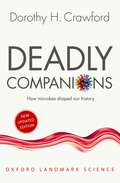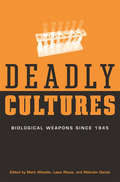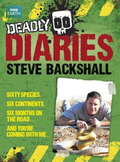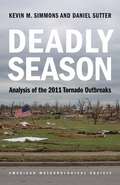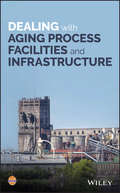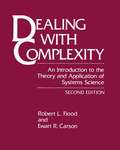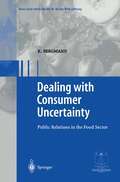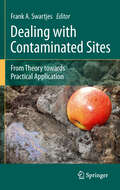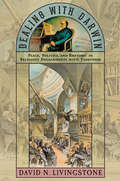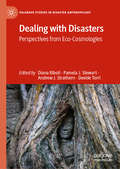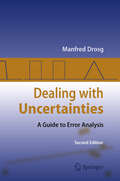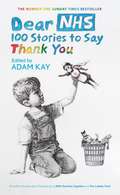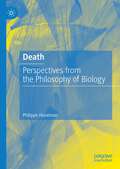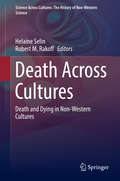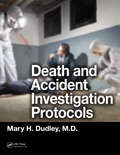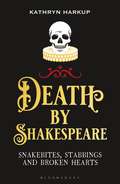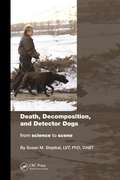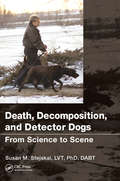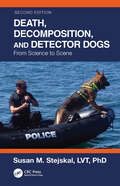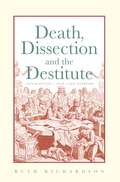- Table View
- List View
Deadly Companions: How Microbes Shaped our History (Oxford Landmark Science)
by Dorothy H. CrawfordEver since we started huddling together in communities, the story of human history has been inextricably entwined with the story of microbes. They have evolved and spread amongst us, shaping our culture through infection, disease, and pandemic. At the same time, our changing human culture has itself influenced the evolutionary path of microbes. Dorothy H. Crawford here shows that one cannot be truly understood without the other. Beginning with a dramatic account of the SARS pandemic at the start of the 21st century, she takes us back in time to follow the interlinked history of microbes and man, taking an up-to-date look at ancient plagues and epidemics, and identifying key changes in the way humans have lived - such as our move from hunter-gatherer to farmer to city-dweller — which made us vulnerable to microbe attack. Showing how we live our lives today — with increasing crowding and air travel — puts us once again at risk, Crawford asks whether we might ever conquer microbes completely, or whether we need to take a more microbe-centric view of the world. Among the possible answers, one thing becomes clear: that for generations to come, our deadly companions will continue to shape human history. Oxford Landmark Science books are 'must-read' classics of modern science writing which have crystallized big ideas, and shaped the way we think.
Deadly Cultures: Biological Weapons since 1945
by Lajos RózsaThe threat of biological weapons has never attracted as much public attention as in the past five years. Current concerns largely relate to the threat of weapons acquisition and use by rogue states or by terrorists. But the threat has deeper roots—it has been evident for fifty years that biological agents could be used to cause mass casualties and large-scale economic damage. Yet there has been little historical analysis of such weapons over the past half-century. Deadly Cultures sets out to fill this gap by analyzing the historical developments since 1945 and addressing three central issues: Why have states continued or begun programs for acquiring biological weapons? Why have states terminated biological weapons programs? How have states demonstrated that they have truly terminated their biological weapons programs? We now live in a world in which the basic knowledge needed to develop biological weapons is more widely available than ever before. Deadly Cultures provides the lessons from history that we urgently need in order to strengthen the long-standing prohibition of biological weapons.
Deadly Diaries (Steve Backshall's Deadly series)
by Steve BackshallIn his first ever DEADLY DIARIES Steve Backshall shares what it means to him to film the world's top predators. Learn how it feels to have a blue whale silently power past you in crystal clear Indian Ocean waters or to dangle beneath a helicopter in order to be dropped onto a crocodile nest while the mother crocodile is still there! The book covers Steve's travels across six continents in six months as he finds the 60 creatures that are most deadly in their world. 224 pages, packed with 175 colour photos to tie in with the third BBC TV series of DEADLY 60.
Deadly Season: Analysis of the 2011 Tornado Outbreaks
by Kevin Simmons Sutter DanielIn 2011, despite continued developments in forecasting, tracking, and warning technology, the United States was hit by the deadliest tornado season in decades. More than 1,200 tornadoes touched down, shattering communities and their safety nets and killing more than 500 people—a death toll unmatched since 1953. Drawing on the unique analysis described in their first book, Economic and Societal Impacts of Tornadoes, economists Kevin M. Simmons and Daniel Sutter here examine the factors that contributed to the outcomes of such tornadoes as the mid-April outbreak that devastated communities in North Carolina, the “Super Outbreak” across the southern and eastern United States in late April, and the single, mile-wide funnel that touched down in Joplin, Missouri, among others, in late May.
Dealing with Aging Process Facilities and Infrastructure
by CCPS (Center for Chemical Process Safety)Examines the concept of aging process facilities and infrastructure in high hazard industries and highlights options for dealing with the problem while addressing safety issues This book explores the many ways in which process facilities, equipment, and infrastructure might deteriorate upon continuous exposure to operating and climatic conditions. It covers the functional and physical failure modes for various categories of equipment and discusses the many warning signs of deterioration. Dealing with Aging Process Facilities and Infrastructure also explains how to deal with equipment that may not be safe to operate. The book describes a risk-based strategy in which plant leaders and supervisors can make more informed decisions on aging situations and then communicate them to upper management effectively. Additionally, it discusses the dismantling and safe removal of facilities that are approaching their intended lifecycle or have passed it altogether. Filled with numerous case studies featuring photographs to illustrate the positive and negative experiences of others who have dealt with aging facilities, Dealing with Aging Process Facilities and Infrastructure covers the causes of equipment failures due to aging and their consequences; plant management commitment and responsibility; inspection and maintenance practices for managing life cycle; specific aging asset integrity management practices; and more. Describes symptoms and causal mechanisms of aging in various categories of process equipment Presents key considerations for making informed risk-based decisions regarding the repair or replacement of aging process facilities and infrastructure Discusses practices for managing process facility and infrastructure life cycle Includes examples and case histories of failures related to aging Dealing with Aging Process Facilities and Infrastructure is an important book for industrial practitioners who are often faced with the challenge of managing process facilities and infrastructure as they approach the end of their useful lifecycle.
Dealing with Aging Process Facilities and Infrastructure
by CCPS (Center for Chemical Process Safety)Examines the concept of aging process facilities and infrastructure in high hazard industries and highlights options for dealing with the problem while addressing safety issues This book explores the many ways in which process facilities, equipment, and infrastructure might deteriorate upon continuous exposure to operating and climatic conditions. It covers the functional and physical failure modes for various categories of equipment and discusses the many warning signs of deterioration. Dealing with Aging Process Facilities and Infrastructure also explains how to deal with equipment that may not be safe to operate. The book describes a risk-based strategy in which plant leaders and supervisors can make more informed decisions on aging situations and then communicate them to upper management effectively. Additionally, it discusses the dismantling and safe removal of facilities that are approaching their intended lifecycle or have passed it altogether. Filled with numerous case studies featuring photographs to illustrate the positive and negative experiences of others who have dealt with aging facilities, Dealing with Aging Process Facilities and Infrastructure covers the causes of equipment failures due to aging and their consequences; plant management commitment and responsibility; inspection and maintenance practices for managing life cycle; specific aging asset integrity management practices; and more. Describes symptoms and causal mechanisms of aging in various categories of process equipment Presents key considerations for making informed risk-based decisions regarding the repair or replacement of aging process facilities and infrastructure Discusses practices for managing process facility and infrastructure life cycle Includes examples and case histories of failures related to aging Dealing with Aging Process Facilities and Infrastructure is an important book for industrial practitioners who are often faced with the challenge of managing process facilities and infrastructure as they approach the end of their useful lifecycle.
Dealing with Complexity: An Introduction to the Theory and Application of Systems Science
by Robert L. Flood Ewart R. CarsonContents 11. 2. 2. Four Main Areas of Dispute 247 11. 2. 3. Summary . . . 248 11. 3. Making Sense of the Issues . . 248 11. 3. 1. Introduction . . . . 248 11. 3. 2. The Scientific Approach 248 11. 3. 3. Science and Matters of Society . 249 11. 3. 4. Summary . 251 11. 4. Tying It All Together . . . . 251 11. 4. 1. Introduction . . . . 251 11. 4. 2. A Unifying Framework 251 11. 4. 3. Critical Systems Thinking 253 11. 4. 4. Summary 254 11. 5. Conclusion 254 Questions . . . 255 REFERENCES . . . . . . . . . . . . . . . . . . . 257 INDEX . . . . . . . . . . . . . . . . . . . . . . 267 Chapter One SYSTEMS Origin and Evolution, Terms and Concepts 1. 1. INTRODUCTION We start this book with Theme A (see Figure P. I in the Preface), which aims to develop an essential and fundamental understanding of systems science. So, what is systems science? When asked to explain what systems science is all about, many systems scientists are confronted with a rather daunting task. The discipline tends to be presented and understood in a fragmented way and very few people hold an overview understanding of the subject matter, while also having sufficient in-depth competence in many and broad-ranging subject areas where the ideas are used. Indeed, it was precisely this difficulty that identified the need for a comprehensive well-documented account such as is presented here in Dealing with Complexity.
Dealing with consumer uncertainty: Public Relations in the Food Sector (Gesunde Ernährung Healthy Nutrition)
by Karin BergmannMy studies on the "uncertain consumer" began with a research project c- ducted by the Dr. Rainer Wild-Stiftung - Foundation for healthy nutrition - on the negative image of processed food. Ever since then I have been asked whether or not growing consumer uncertainty is linked to information po- cies of the food sector and if so, how. Intensive three-year research showed that industrial methods of food production are predestined to result in wayward fears and worry over its healthiness. This is due to the fact that during the process of industrialisation, we gradually passed responsibility for the quality of food into the producers' hands. This, in turn, has resulted in information gaps that we, as the addressees of diverse, often overwhelming and contrad- tory information supplied by varying sources, feel today. We exchanged the daily search for food for the daily search for information long ago. Con- quently, a practical concept for public relations stands at the end of my - search into the uncertain consumer. It accounts for uncertainty regarding processed food as a point of reference for public relations targeted towards various groups. Public relations oriented towards the future calls for the sharing of expert information with all interested consumers. It is the goal of businesses to actively build up trust among the consumers in order to be prepared for new causes for uncertainty appearing periodically. To this day the issue of consumer uncertainty has not lost its topicality.
Dealing with Contaminated Sites: From Theory towards Practical Application
by Frank A. SwartjesThis standard work on contaminated site management covers the whole chain of steps involved in dealing with contaminated sites, from site investigation to remediation. An important focus throughout the book is on Risk Assessment. In addition, the book includes chapters on characterisation of natural and urban soils, bioavailability, natural attenuation, policy and stakeholder viewpoints and Brownfields. Typically, the book includes in-depth theories on soil contamination, along with offering possibilities for practical applications. More than sixty of the world’s top experts from Europe, the USA, Australia and Canada have contributed to this book. The twenty-five chapters in this book offer relevant information for experienced scientists, students, consultants and regulators, as well as for ‘new players’ in contaminated site management
Dealing with Darwin: Place, Politics, and Rhetoric in Religious Engagements with Evolution (Medicine, Science, and Religion in Historical Context)
by David N. LivingstoneUsing place, politics, and rhetoric as analytical tools, historical geographer David N. Livingstone investigates how religious communities sharing a Scots Presbyterian heritage engaged with Darwin and Darwinism at the turn of the twentieth century. His findings, presented as the prestigious Gifford Lectures, transform our understandings of the relationship between science and religion.The particulars of placeâ€�whether in Edinburgh, Belfast, Toronto, Princeton, or Columbia, South Carolinaâ€�shaped the response to Darwin’s theories. Were they tolerated, repudiated, or welcomed? Livingstone shows how Darwin was read in different ways, with meaning distilled from Darwin's texts depending on readers' own historiesâ€�their literary genealogies and cultural preoccupations. That the theory of evolution fared differently in different places, Livingstone writes, is "exactly what Darwin might have predicted. As the theory diffused, it diverged." Dealing with Darwin shows the profound extent to which theological debates about evolution were rooted in such matters as anxieties over control of education, the politics of race relations, the nature of local scientific traditions, and challenges to traditional cultural identity. In some settings, conciliation with the new theory, even endorsement, was possibleâ€�demonstrating that attending to the specific nature of individual communities subverts an inclination to assume a single relationship between science and religion in general, evolution and Christianity in particular. Livingstone concludes with contemporary examples to remind us that what scientists can say and what others can hear in different venues differ today just as much as they did in the past.
Dealing with Darwin: Place, Politics, and Rhetoric in Religious Engagements with Evolution (Medicine, Science, and Religion in Historical Context)
by David N. LivingstoneUsing place, politics, and rhetoric as analytical tools, historical geographer David N. Livingstone investigates how religious communities sharing a Scots Presbyterian heritage engaged with Darwin and Darwinism at the turn of the twentieth century. His findings, presented as the prestigious Gifford Lectures, transform our understandings of the relationship between science and religion.The particulars of place—whether in Edinburgh, Belfast, Toronto, Princeton, or Columbia, South Carolina—shaped the response to Darwin’s theories. Were they tolerated, repudiated, or welcomed? Livingstone shows how Darwin was read in different ways, with meaning distilled from Darwin's texts depending on readers' own histories—their literary genealogies and cultural preoccupations. That the theory of evolution fared differently in different places, Livingstone writes, is "exactly what Darwin might have predicted. As the theory diffused, it diverged." Dealing with Darwin shows the profound extent to which theological debates about evolution were rooted in such matters as anxieties over control of education, the politics of race relations, the nature of local scientific traditions, and challenges to traditional cultural identity. In some settings, conciliation with the new theory, even endorsement, was possible—demonstrating that attending to the specific nature of individual communities subverts an inclination to assume a single relationship between science and religion in general, evolution and Christianity in particular. Livingstone concludes with contemporary examples to remind us that what scientists can say and what others can hear in different venues differ today just as much as they did in the past.
Dealing with Disasters: Perspectives from Eco-Cosmologies (Palgrave Studies in Disaster Anthropology)
by Diana Riboli Pamela J. Stewart Andrew J. Strathern Davide TorriProviding a fresh look at some of the pressing issues of our world today, this collection focuses on experiential and ritualized coping practices in response to a multitude of environmental challenges—cyclones, volcanic eruptions, tsunamis, earthquakes, warfare and displacements of peoples and environmental resource exploitation. Eco-cosmological practices conducted by skilled healing practitioners utilize knowledge embedded in the cosmological grounding of place and experiences of place and the landscapes in which such experience is encapsulated. A range of geographic case studies are presented in this volume, exploring Asia, Europe, the Pacific, and South America. With special reference throughout to ritual as a mode of seeking the stabilization, renewal, and continuity of life processes, this volume will be of particular interest to readers working in shamanic and healing practices, environmental concerns surrounding sustainability and conservation, ethnomedical systems, and religious and ritual studies.
Dealing with Uncertainties: A Guide to Error Analysis
by Manfred DrosgDealing with Uncertainties is an innovative monograph that lays special emphasis on the deductive approach to uncertainties and on the shape of uncertainty distributions. This perspective has the potential for dealing with the uncertainty of a single data point and with sets of data that have different weights. It is shown that the inductive approach that is commonly used to estimate uncertainties is in fact not suitable for these two cases. The approach that is used to understand the nature of uncertainties is novel in that it is completely decoupled from measurements. Uncertainties which are the consequence of modern science provide a measure of confidence both in scientific data and in information in everyday life. Uncorrelated uncertainties and correlated uncertainties are fully covered and the weakness of using statistical weights in regression analysis is discussed. The text is abundantly illustrated with examples and includes more than 150 problems to help the reader master the subject.
Dear NHS: 100 Stories to Say Thank You, Edited by Adam Kay
by VariousCurated and edited by Adam Kay (author of multi-million bestseller This is Going to Hurt), Dear NHS features 100 household names telling their personal stories of the health service. Contributors include: Paul McCartney, Emilia Clarke, Peter Kay, Stephen Fry, Dawn French, Sir Trevor McDonald, Graham Norton, Sir Michael Palin, Naomie Harris, Ricky Gervais, Sir David Jason, Dame Emma Thompson, Joanna Lumley, Miranda Hart, Dermot O'Leary, Jamie Oliver, Ed Sheeran, David Tennant, Dame Julie Walters, Emma Watson, Malala Yousafzai and many, many more. All profits from this book will go to NHS Charities Together to fund vital research and projects, and The Lullaby Trust which supports parents bereaved of babies and young children.Other writers include Chris O'Dowd, Johnny Vegas, Jack Whitehall, Chris Evans, Lorraine Kelly, Lee Mack, Jonathan Ross, Konnie Huq, Greg James, Frank Skinner, Louis Theroux, KT Tunstall, Sandi Toksvig and Kevin Bridges. The NHS is our single greatest achievement as a country. No matter who you are, no matter what your health needs are, and no matter how much money you have, the NHS is there for you. In Dear NHS, 100 inspirational people come together to share their stories of how the national health service has been there for them, and changed their lives in the process. By turns deeply moving, hilarious, hopeful and impassioned, these stories together become a love letter to the NHS and the 1.4 million people who go above and beyond the call of duty every single day - selflessly, generously, putting others before themselves, never more so than now. They are all heroes, and this book is our way of saying thank you.Contributors include: Dolly Alderton, Monica Ali, Kate Atkinson, Pam Ayres, David Baddiel, Johanna Basford, Mary Beard, William Boyd, Frankie Boyle, Jo Brand, Kevin Bridges, Alex Brooker, Charlie Brooker, Rob Brydon, Bill Bryson, Kathy Burke, Peter Capaldi, Jimmy Carr, Candice Carty-Williams, Lauren Child, Lee Child, Bridget Christie, Emilia Clarke, Rev Richard Coles, Daisy May Cooper, Jilly Cooper, Fearne Cotton, Juno Dawson, Kit de Waal, Victoria Derbyshire, Reni Eddo-Lodge, Chris Evans, Anne Fine, Martin Freeman, Dawn French, Stephen Fry, Mark Gatiss, Ricky Gervais, Professor Green, Baroness Tanni Grey-Thompson, Mark Haddon, Matt Haig, The Hairy Bikers, Naomie Harris, Miranda Hart, Victoria Hislop, Nick Hornby, Sali Hughes, Konnie Huq, Marina Hyde, E L James, Greg James, Sir David Jason, Katarina Johnson-Thompson, Jackie Kay, Peter Kay, Lorraine Kelly, Marian Keyes, Shappi Khorsandi, Nish Kumar, Stewart Lee, Joanna Lumley, Lee Mack, Emily Maitlis, Andrew Marr, Catherine Mayer, Alexander McCall Smith, Paul McCartney, Sir Trevor McDonald, Caitlin Moran, Kate Mosse, Jojo Moyes, David Nicholls, John Niven, Graham Norton, Chris O'Dowd, Dermot O'Leary, Jamie Oliver, Sir Michael Palin, Maxine Peake, Sue Perkins, Katie Piper, Ian Rankin, Jonathan Ross, Ed Sheeran, Paul Sinha, Frank Skinner, Matthew Syed, Kate Tempest, David Tennant, Louis Theroux, Dame Emma Thompson, Sandi Toksvig, Stanley Tucci, KT Tunstall, Johnny Vegas, Danny Wallace, Dame Julie Walters, Phil Wang, Emma Watson, Mark Watson, Robert Webb, Irvine Welsh, Jack Whitehall, Josh Widdicombe, Dame Jacqueline Wilson, Greg Wise, Malala Yousafzai, Benjamin Zephaniah.A minimum of £3.00 from the sale of each book will be paid to NHS Charities Together and £0.15 will be paid to The Lullaby Trust.
Death: Perspectives from the Philosophy of Biology
by Philippe HunemanThis book addresses several key issues in the biological study of death with the intent of capturing their genealogy, the assumptions and presuppositions they make, and the way that they open specific new research avenues. The book is divided into two sections: the first considers physiology and the second evolutionary biology. Huneman explains that biologists in the late 1950s put forth a research framework that evolutionarily accounts for death in terms of either an effect of the weakness of natural selection or a by-product of natural selection for early reproduction. He illustrates how the biology of death is a central field and that studying it provides insight into the way that the epistemic structure of this knowledge has been constituted, persists until now, and may conflict with some traditional philosophical ideas.
Death Across Cultures: Death and Dying in Non-Western Cultures (Science Across Cultures: The History of Non-Western Science #9)
by Helaine Selin Robert M. RakoffDeath Across Cultures: Death and Dying in Non-Western Cultures, explores death practices and beliefs, before and after death, around the non-Western world. It includes chapters on countries in Africa, Asia, South America, as well as indigenous people in Australia and North America. These chapters address changes in death rituals and beliefs, medicalization and the industry of death, and the different ways cultures mediate the impacts of modernity. Comparative studies with the west and among countries are included. This book brings together global research conducted by anthropologists, social scientists and scholars who work closely with individuals from the cultures they are writing about.
Death and Accident Investigation Protocols
by Mary H. DudleyThrough an examination and assessment of the body at a death scene, the medicolegal death investigator (MLDI) must be able to recognize circumstances that point to what manner of death occurred be it natural causes, homicide, suicide, accident, or undetermined. A handy reference for use in the field and in the lab, Death and Accident Investigation
Death By Shakespeare: Snakebites, Stabbings and Broken Hearts
by Kathryn HarkupFrom the bestselling author of A is for ArsenicWilliam Shakespeare found dozens of different ways to kill off his characters, and audiences today still enjoy the same reactions – shock, sadness, fear – that they did more than 400 years ago when these plays were first performed. But how realistic are these deaths, and did Shakespeare have the knowledge to back them up?In the Bard's day death was a part of everyday life. Plague, pestilence and public executions were a common occurrence, and the chances of seeing a dead or dying body on the way home from the theatre were high. It was also a time of important scientific progress. Shakespeare kept pace with anatomical and medical advances, and he included the latest scientific discoveries in his work, from blood circulation to treatments for syphilis. He certainly didn't shy away from portraying the reality of death on stage, from the brutal to the mundane, and the spectacular to the silly. Elizabethan London provides the backdrop for Death by Shakespeare, as Kathryn Harkup turns her discerning scientific eye to the Bard and the varied and creative ways his characters die. Was death by snakebite as serene as Shakespeare makes out? Could lack of sleep have killed Lady Macbeth? Can you really murder someone by pouring poison in their ear? Kathryn investigates what actual events may have inspired Shakespeare, what the accepted scientific knowledge of the time was, and how Elizabethan audiences would have responded to these death scenes. Death by Shakespeare will tell you all this and more in a rollercoaster of Elizabethan carnage, poison, swordplay and bloodshed, with an occasional death by bear-mauling for good measure.
Death, Decomposition And Detector Dogs: From Science To Scene (PDF)
by Susan M. StejskalDeath, Decomposition, and Detector Dogs: From Science to Scene is designed to help police investigators and Human Remains Detection K9 handlers understand the basics of forensic taphonomy (decomposition) and how to most effectively use a human remains detection (HRD) K9 as a locating tool. The book covers basic anatomy and the physiology of canine olfaction along with some of the unique characteristics that allow a dog to work. Using concise and understandable explanations along with numerous photographs, the book covers the stages of decomposition and how they are affected by the environment; what is currently understood about the chemical profile of odor from human remains; how weather, topography, ground cover and terrain can affect odor dispersion; and different types of mapping and weather data that can be used before and during deployment of the HRD K9. The final chapter ties it all together by providing case reports about decedents who have been found in different locations in a variety of environmental conditions. By learning how these variables can affect how and what is found, handlers and investigators will be better prepared to meet the challenges of their jobs.
Death, Decomposition And Detector Dogs: From Science To Scene (PDF)
by Susan M. StejskalDeath, Decomposition, and Detector Dogs: From Science to Scene is designed to help police investigators and Human Remains Detection K9 handlers understand the basics of forensic taphonomy (decomposition) and how to most effectively use a human remains detection (HRD) K9 as a locating tool. The book covers basic anatomy and the physiology of canine olfaction along with some of the unique characteristics that allow a dog to work. Using concise and understandable explanations along with numerous photographs, the book covers the stages of decomposition and how they are affected by the environment; what is currently understood about the chemical profile of odor from human remains; how weather, topography, ground cover and terrain can affect odor dispersion; and different types of mapping and weather data that can be used before and during deployment of the HRD K9. The final chapter ties it all together by providing case reports about decedents who have been found in different locations in a variety of environmental conditions. By learning how these variables can affect how and what is found, handlers and investigators will be better prepared to meet the challenges of their jobs.
Death, Decomposition, and Detector Dogs: From Science to Scene
by Susan M. StejskalDeath, Decomposition, and Detector Dogs: From Science to Scene is designed to help police investigators and Human Remains Detection K9 handlers understand the basics of forensic taphonomy (decomposition) and how to most effectively use a human remains detection (HRD) K9 as a locating tool. The book covers basic anatomy and the physiology of canine
Death, Decomposition, and Detector Dogs: From Science to Scene
by Susan M. StejskalDeath, Decomposition, and Detector Dogs: From Science to Scene is designed to help police investigators and Human Remains Detection K9 handlers understand the basics of forensic taphonomy (decomposition) and how to most effectively use a human remains detection (HRD) K9 as a locating tool. The book covers basic anatomy and the physiology of canine
Death, Decomposition, and Detector Dogs: From Science to Scene
by Susan M. StejskalDeath, Decomposition, and Detector Dogs: From Science to Scene, Second Edition is designed to help canine handlers, detectives, death investigators, crime scene personnel (including forensic laboratory personnel, technicians, and supervisors), and attorneys understand the science involved when utilizing human remains detector (HRD) canines as a locating tool. The book covers the basic anatomy and physiology of canine olfaction and the unique characteristics of their scenting ability that allows dogs to be trained to locate distinct odors. Using concise and clear explanations and photographs, the book reviews the science of forensic taphonomy. Factors that may affect the decomposition process are highlighted along with what the potential outcomes that may be encountered. The book examines how the odor of human remains is generated through various stages of decomposition and the manner in which environmental conditions in both land and water settings may affect that odor. Different types of background information that may help in determining possible search locations for missing individuals are included as well as assist the HRD canine handler in developing search plans are covered. Different tools and technologies that may be used in addition to an HRD canine team are included to help readers understand that are many ways to address searching for a decedent. Several case reports involving decedents, found in both land and water settings in addition to different weather conditions, are included to help the reader understand how the environment may have affected the condition of the decedent. This edition includes more case reports explaining how environmental factors were considered in HRD canine deployments in both land and water settings. Understanding which variables—and how such variables—can affect the state and condition of human remains, as well as dispersion of odor from human remains, will help canine handlers utilize their HRD canine more effectively as a locating tool. Death, Decomposition, and Detector Dogs, Second Edition will help HRD canine handlers and other law enforcement personnel be better prepared to meet the challenges of their jobs before, during, and after searches for the missing.
Death, Decomposition, and Detector Dogs: From Science to Scene
by Susan M. StejskalDeath, Decomposition, and Detector Dogs: From Science to Scene, Second Edition is designed to help canine handlers, detectives, death investigators, crime scene personnel (including forensic laboratory personnel, technicians, and supervisors), and attorneys understand the science involved when utilizing human remains detector (HRD) canines as a locating tool. The book covers the basic anatomy and physiology of canine olfaction and the unique characteristics of their scenting ability that allows dogs to be trained to locate distinct odors. Using concise and clear explanations and photographs, the book reviews the science of forensic taphonomy. Factors that may affect the decomposition process are highlighted along with what the potential outcomes that may be encountered. The book examines how the odor of human remains is generated through various stages of decomposition and the manner in which environmental conditions in both land and water settings may affect that odor. Different types of background information that may help in determining possible search locations for missing individuals are included as well as assist the HRD canine handler in developing search plans are covered. Different tools and technologies that may be used in addition to an HRD canine team are included to help readers understand that are many ways to address searching for a decedent. Several case reports involving decedents, found in both land and water settings in addition to different weather conditions, are included to help the reader understand how the environment may have affected the condition of the decedent. This edition includes more case reports explaining how environmental factors were considered in HRD canine deployments in both land and water settings. Understanding which variables—and how such variables—can affect the state and condition of human remains, as well as dispersion of odor from human remains, will help canine handlers utilize their HRD canine more effectively as a locating tool. Death, Decomposition, and Detector Dogs, Second Edition will help HRD canine handlers and other law enforcement personnel be better prepared to meet the challenges of their jobs before, during, and after searches for the missing.
Death, Dissection and the Destitute: The Politics Of The Corpse In Pre-victorian Britain (Pelican Ser.)
by Ruth RichardsonIn the early nineteenth century, body snatching was rife because the only corpses available for medical study were those of hanged murderers. With the Anatomy Act of 1832, however, the bodies of those who died destitute in workhouses were appropriated for dissection. At a time when such a procedure was regarded with fear and revulsion, the Anatomy Act effectively rendered dissection a punishment for poverty. Providing both historical and contemporary insights, Death, Dissection, and the Destitute opens rich new prospects in history and history of science. The new afterword draws important parallels between social and medical history and contemporary concerns regarding organs for transplant and human tissue for research.
